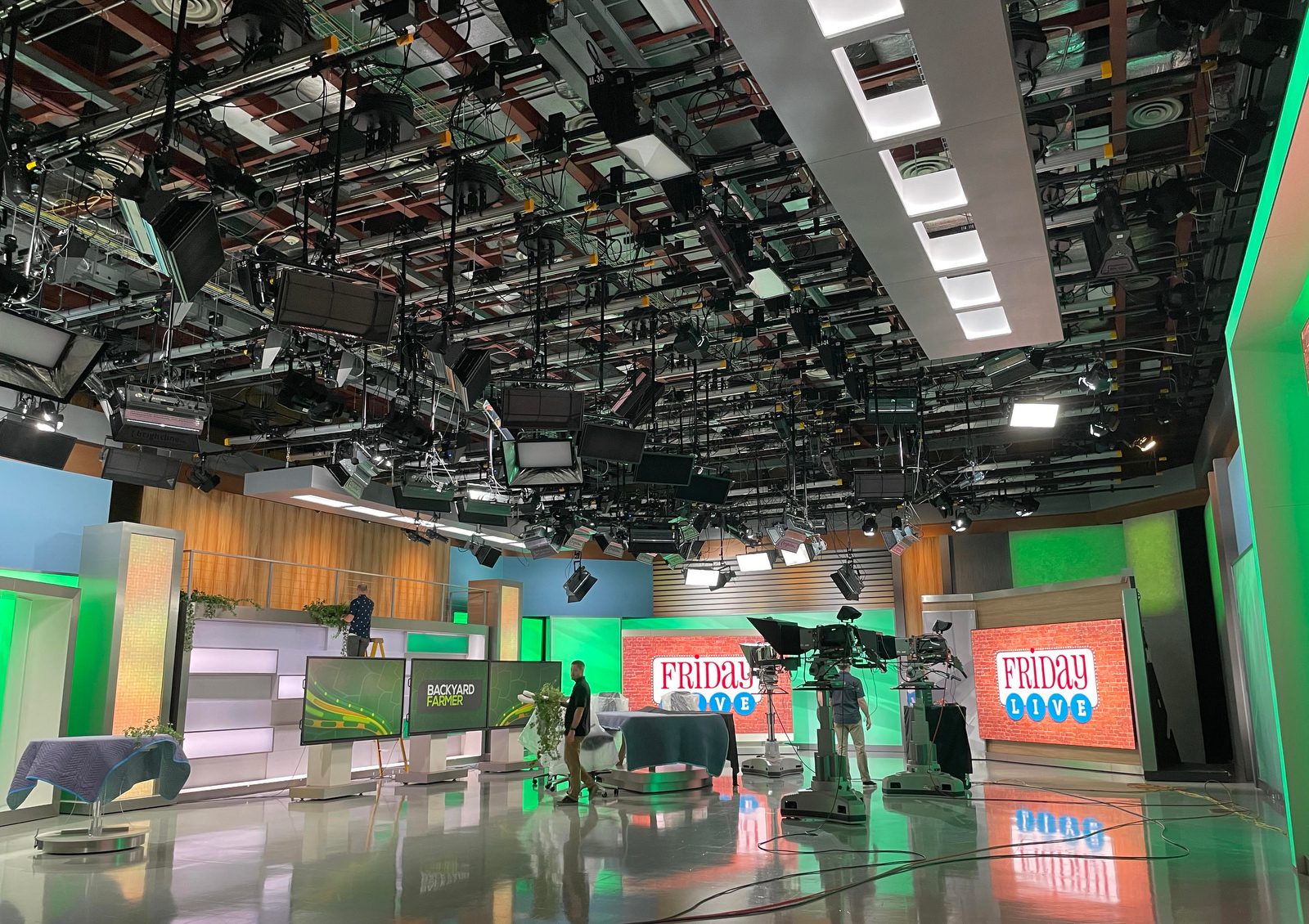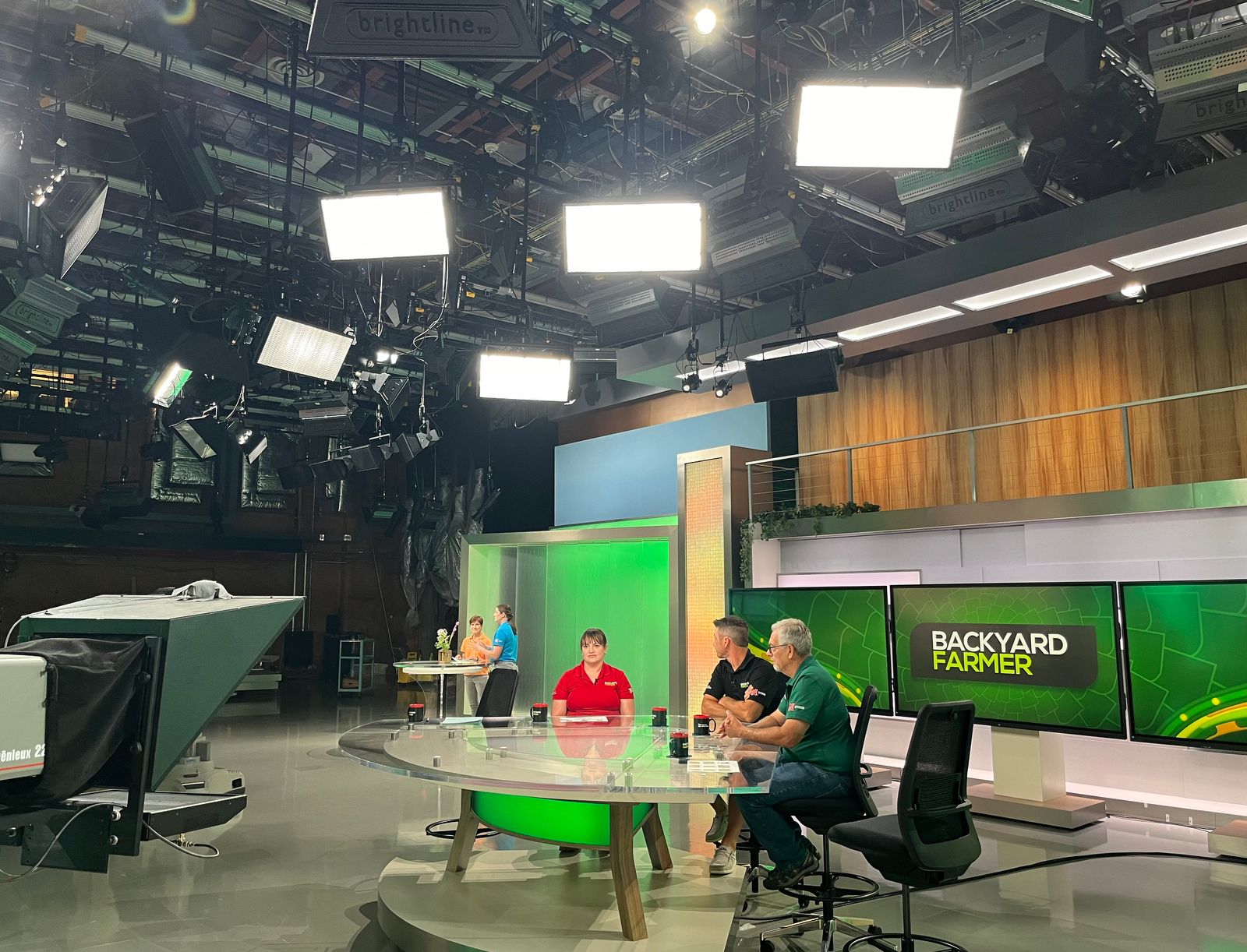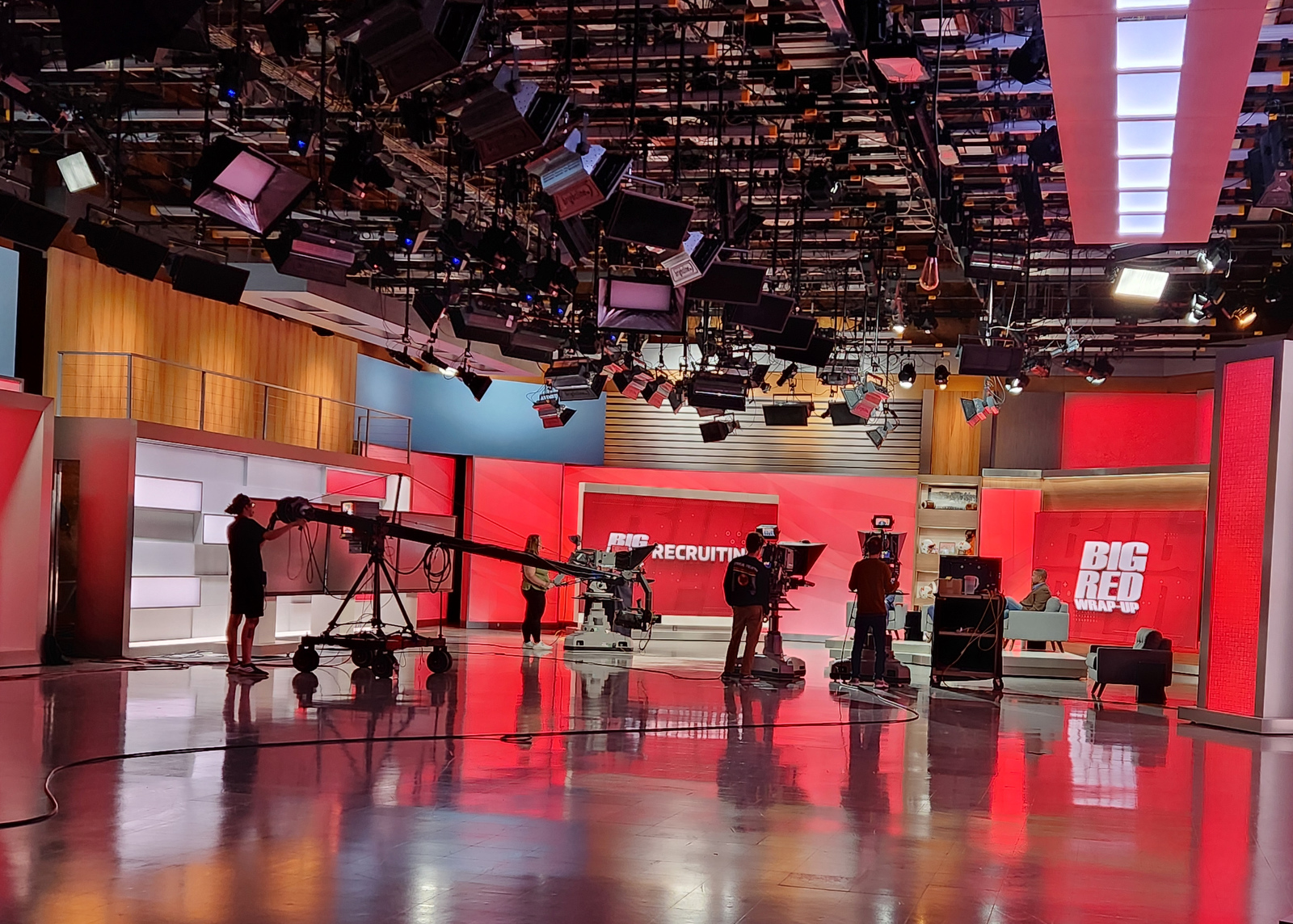Subscribe to NewscastStudio for the latest news, project case studies and product announcements in broadcast technology, creative design and engineering delivered to your inbox.
In the heart of the Midwest, nestled within the expansive landscape of Nebraska, lies a broadcast studio that has been a beacon of innovation and creativity since its inception. Built in 1968 and commissioned in 1970, the Ron Hull Studio is a colossal 100 feet by 60 feet space located on the University of Nebraska’s Lincoln campus. Its original rigging plan with 109 motorized lighting battens was an engineering marvel typically found only in major media hubs like Los Angeles and New York City. As one of the first states to produce educational programming, the shows that came from this studio were as pioneering as its physical infrastructure.
For decades, the Ron Hull Studio hosted a variety of productions that brought the state’s stories to life, including the iconic shows “Backyard Farmer,” and “Big Red Wrap Up.” “Backyard Farmer” has been on the air for 72 years and is the longest-running locally produced public television series in the United States. The broadcaster has a second smaller studio, 40’x 60’ with “green screen” capabilities.
Fast forward to today, and the historic Ron Hull Studio has undergone a complete transformation. Its original lighting system, designed for incandescent loads, had been through one revision, but it was clear that a more comprehensive overhaul was necessary to meet the demands of modern production. Nebraska Public Media’s Doug Carlson, former Director of Production Services, and Nancy Finken, Chief Content Officer, recognized that the studio needed a full overhaul. Carlson agreed to come back after retirement to help manage the project.
The decision to upgrade was based on several factors. The existing motors and rigging systems were outdated and no longer functioning optimally. The control panels required manual patching and were prone to electrical arcing and burnout. Additionally, the studio’s production values were falling behind the more vibrant look of current programming. With the knowledge that viewers have a plethora of entertainment options to choose from, the need to maintain a more visually compelling broadcast became a pressing concern.
The importance of rigging
One of the most significant aspects of the Ron Hull Studio upgrade was the complete revamp of the rigging system. The original setup, while groundbreaking in its time, was in dire need of an upgrade. The new design had to retain the flexibility that made the original studio so versatile while incorporating the latest in rigging technology. One of the country’s top lighting designers, Norman Russell, Principal Consultant and Lighting Group Leader for NV5, served as consultant designer for the project. Russell designed the rigging and lighting systems with design and engineering support by NV5 Senior Lighting Designer Steve Cooper.


“The original rigging system while a marvel in its time, didn’t fit their current and future needs,” explains Russell. “We created a design that preserved the studio’s incredible flexibility while anticipating the challenges of the next few decades.”
The first step in the process was to strip the studio back to its bones. All the lights were taken down, the pipes lowered, and the old motors and rigging systems removed. What remained was a blank canvas, ready to be outfitted with a cutting-edge rigging system that would serve the studio for the next 30 years.
Advertisement


Rows of package hoists, each about 12 to 14 feet wide, were installed along the studio’s 100-foot length, with three hoists per row, 20 rows. This setup provided ample support for lighting fixtures, scenic elements, and other production equipment, allowing for a wide range of configurations depending on the needs of the production. In total, 60 new hoists were installed, a significant reduction from the original 109, but with equivalent functionality and far greater safety.
Around the perimeter of the studio, a fixed pipe grid was installed, providing additional rigging points for scenic elements, backlights, and other equipment. This grid, located about 20 feet above the deck or soundstage was designed to be level with the top trim of the flying pipes when they were fully raised.
Lighting heaven: The power of LED technology
While the rigging system forms the bones of the studio, lighting design is crucial in creating the new look. The Ron Hull Studio’s lighting system upgrade marked a significant shift from the old dimmer-per-circuit system to a state-of-the-art network driver system with LED fixtures. “The move to LED was not just about following current trends—it was about efficiency, sustainability, and giving our production team the tools they need to create the best possible content,” says Russell. “LEDs offer incredible flexibility in terms of color temperature, intensity, and energy consumption. It was a no-brainer for this upgrade.”
The old dimmer-per-circuit system relied on many SCR (Silicon Controlled Rectifiers) dimmers, each responsible for controlling the output of one or more lighting fixtures. While this system worked well for incandescent lighting, it wasn’t suited to the more complex demands of LED lights, which provide precise control over intensity, color, and beam angle.


In the new network driver system, each LED fixture is equipped with its own driver — a small electronic device that controls the output of the LED from zero to 100%. A Local Area Network was installed to distribute DMX control signals to all luminaire mounting positions to address drivers. The existing dimmer bank was repurposed to act as a relay panel to provide constant power to the LED luminaires using the existing load circuit distribution.
Lighting designers can now place fixtures wherever they like and adjust settings with precision, dialing in the exact intensity, color, and beam angle required for each shot. This level of control is especially important in a studio like this one, where different productions have their own unique lighting requirements.
Lighting designer/director Chris Boyd installed the fixtures and programmed the lighting’s DMX controllers, alongside Lighting Designer Erik Rodgers.
The Ron Hull Studio hosts about a dozen different productions with multiple sets,” explains Boyd. “Some are weekly, some seasonal, but they each have a slightly different look. But each production needs to say Nebraska Public Media while retaining its own character. Now, we have so many fixtures, angles and options for producers. With the new lighting and rigging we’ve employed, they can achieve a wide range of lighting effects that were simply not possible before. This opens up entirely new creative possibilities for them.”
Russell echoes that enthusiasm for the revamped studio: “The flexibility starts in the rig with being able to decide where each fixture goes. Each fixture can be located and dialed in precisely to where the user wants it. It’s truly heaven for a lighting designer. There are a variety of different places to hang fixtures and angles for whatever you want. If you can’t create great lighting in this studio, you’re just not trying very hard.”
A collaboration of experts: Brightline and Devlin Design Group
To ensure that the lighting system met the highest standards, Nebraska Public Media brought in one of the top names in the lighting business: Brightline. The latest Brightline studio LED lighting is in use at high-profile broadcast stations throughout the U.S., including several owned by Scripps Media and Sinclair Broadcast Group.
Brightline’s Series One L1.4 and L1.2 LED studio fixtures were key in the new lighting system. Russell describes them as superior “directional soft lights. It’s not at all your typical directional light. They don’t create a real sharp edge. Typically, you put a profile spot on the subject, and boom, you’ve got a big drop shadow. It can be hard to get rid of that edge. But with a soft light with a soft edge like the L1.4 and L1.2’s, you can accomplish a long throw without that hard edge — even with an intense amount of light. Adding an intensifier with a narrow angle, you get a nice, tight field that’s very bright but still has a soft edge. For my money, Brightline provides the best studio lighting for TV available today.”
Advertisement


Brightline Mako and Minnow profile spotlights and Lupo Fresnels are also included in the lighting redesign. “They offer a comprehensive package,” reports Russell. “And all the fixtures are very competitive in terms of cost and performance. Sometimes there could be several luminaires listed on a job. But with all your gear coming from one source, communication is so much simpler. I really appreciate that Brightline has an array of luminaires.”
In addition to the new lighting system, the studio’s set design was also given a major overhaul, thanks to the work of Devlin Design Group (DDG). Known for their innovative and visually striking designs, DDG worked closely with Nebraska Public Media’s producers to create a set that could accommodate the wide range of productions hosted in the Ron Hull Studio. The new design not only looks stunning on camera but takes full advantage of the studio’s upgraded rigging and lighting systems, allowing for seamless transitions between different shows.
“Working with Brightline and DDG was a pleasure,” Russell reports. “Their expertise and creativity were essential to the success of this project. Together, we’ve created a studio that is not only functional but a joy to work in.”
A studio for the next 50 years
The completion of the Ron Hull Studio upgrade marks a new chapter in the history of Nebraska Public Media. What was once a pioneering studio in the 1970s has been reborn as a state-of-the-art facility. The new rigging and lighting systems offer a level of flexibility and control that would have been unimaginable when the studio was first built, ensuring that it Studio One remains a vital part of Nebraska’s media landscape for decades to come.


Kathy Katz, Managing Director of Brightline, emphasized the impact of these changes: “With the new studio LED lighting systems, Nebraska Public Media is not just more energy-efficient, but it also has the versatility needed to meet the creative demands necessary today. This upgrade enables them to continue to produce engaging, quality content with greater ease and reliability. We couldn’t be happier to be a part of this upgrade for Nebraska Public Media.”
The upgrade is about more than just technology. It’s a testament to the commitment of Nebraska Public Media’s staff, who have worked tirelessly to ensure that the studio remains a leader in the industry. It’s also a reflection of the station’s deep connection to its audience, who expect the highest standards of production from their local public broadcaster.
The people behind the project
The success of the Ron Hull Studio upgrade is due in large part to the dedication and expertise of the team behind the project led by Nancy Finken, Chief Content Officer. Doug Carlson, retired Director of Production Services and Chad Mayer, Director of Production Services played a key role in overseeing the upgrade, working closely with both the design and construction teams to ensure that every detail was executed to perfection. Their deep understanding of the studio’s history and its importance to Nebraska Public Media and technical expertise was instrumental in guiding the project to completion.
Gavin Felix, Director of Television and Digital Production, provided invaluable insight into the needs of the station’s various productions. Collaboration from station leaders with the design team ensured that the new studio would not only meet the technical requirements of modern production but also enhance the storytelling capabilities of Nebraska Public Media’s content.
Doug Anderson, Branch Manager of IES Commercial & Industrial, provided general contracting support alongside key systems integrator/ sub-contractor, Heartland Scenic Studios, for all demolition, removal and installation work.
A bright future for Nebraska Public Media
As Nebraska Public Media looks to the future, the upgraded Ron Hull Studio stands as a symbol of the station’s commitment to providing top tier programming to its audience. The new rigging and lighting systems provide the flexibility and control needed to produce high-quality content. But more than that, they ensure that the studio will continue to be a place where stories are brought to life, where creativity flourishes, and where the legacy of Nebraska Public Media is carried forward into the next 50 years.
In a world where media landscapes are constantly evolving, the Ron Hull Studio’s transformation is a reminder that sometimes, the best way to stay ahead is to honor the past while embracing the future. With its state-of-the-art technology and a renewed sense of purpose, the future of Nebraska Public Media looks brighter than ever.
The lighting updates in the Ron Hull Studio at Nebraska Public Media include:
Brightline L1.2X variable white with DMX control (6x)
Brightline L1.4 variable white with DMX control (57x)
Mako/2 variable white profile spotlight with DMX control (31x)
Minnow/2 variable white profile spotlight with DMX control (15x)
Mako/5 RGBAL profile spotlight with DMX control (10x)
Lupo 650 DMX variable white Fresnel (8)
Lupo 1000 DMX variable white Fresnel (33)
Lupo 2000 DMX variable white Fresnel (4)
Flex-T1 with DMX control (14x)
Case study contributed by Brightline.
Subscribe to NewscastStudio for the latest news, project case studies and product announcements in broadcast technology, creative design and engineering delivered to your inbox.

Source link : http://www.bing.com/news/apiclick.aspx?ref=FexRss&aid=&tid=66e614a705fd4fdfbbc22cca748f09c6&url=https%3A%2F%2Fwww.newscaststudio.com%2F2024%2F09%2F13%2Fnebraska-public-medias-iconic-studio-undergoes-major-revamp-of-rigging-and-lighting-systems%2F&c=7166096892508570874&mkt=en-us
Author :
Publish date : 2024-09-13 01:29:00
Copyright for syndicated content belongs to the linked Source.
